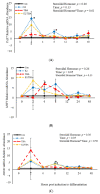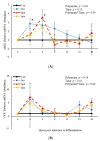The Impact of Polyamine Precursors, Polyamines, and Steroid Hormones on Temporal Messenger RNA Abundance in Bovine Satellite Cells Induced to Differentiate
- PMID: 33801966
- PMCID: PMC8001141
- DOI: 10.3390/ani11030764
The Impact of Polyamine Precursors, Polyamines, and Steroid Hormones on Temporal Messenger RNA Abundance in Bovine Satellite Cells Induced to Differentiate
Abstract
Emerging research suggests that hormones found in anabolic implants interact with polyamine biosynthesis. The objective of this study was to determine the effects of steroidal hormones, polyamines and polyamine precursors on bovine satellite cell (BSC) differentiation and polyamine biosynthesis temporally. Primary BSCs were induced to differentiate in 3% horse serum (CON) and treated with 10 nM trenbolone acetate (TBA), 10 nM estradiol (E2), 10 nM TBA and 10 nM E2, 10 mM methionine, 8 mM ornithine, 2 mM putrescine, 1.5 mM spermidine, or 0.5 mM spermine. Total mRNA was isolated 0, 2, 4, 8, 12, 24, and 48 h post-treatment. Abundance of mRNA for genes associated with induction of BSC differentiation: paired box transcription factor 7, myogenic factor 5, and myogenic differentiation factor 1 and genes in the polyamine biosynthesis pathway: ornithine decarboxylase and S-adenosylmethionine-were analyzed. Overall, steroidal hormones did not impact (p > 0.05) mRNA abundance of genes involved in BSC differentiation, but did alter (p = 0.04) abundance of genes involved in polyamine biosynthesis. Polyamine precursors influenced (p < 0.05) mRNA of genes involved in BSC differentiation. These results indicate that polyamine precursors and polyamines impact BSC differentiation and abundance of mRNA involved in polyamine biosynthesis, while steroidal hormones altered the mRNA involved in polyamine biosynthesis.
Keywords: anabolic implants; beef; bovine satellite cells; polyamines; skeletal muscle.
Conflict of interest statement
The authors declare no conflict of interest.
Figures









Similar articles
-
Understanding the Effects of Trenbolone Acetate, Polyamine Precursors, and Polyamines on Proliferation, Protein Synthesis Rates, and the Abundance of Genes Involved in Myoblast Growth, Polyamine Biosynthesis, and Protein Synthesis in Murine Myoblasts.Biology (Basel). 2023 Mar 14;12(3):446. doi: 10.3390/biology12030446. Biology (Basel). 2023. PMID: 36979138 Free PMC article.
-
Understanding the influence of trenbolone acetate and polyamines on proliferation of bovine satellite cells.Domest Anim Endocrinol. 2021 Jan;74:106479. doi: 10.1016/j.domaniend.2020.106479. Epub 2020 Mar 31. Domest Anim Endocrinol. 2021. PMID: 32615508
-
Oxytocin is involved in steroid hormone-stimulated bovine satellite cell proliferation and differentiation in vitro.Domest Anim Endocrinol. 2019 Jan;66:1-13. doi: 10.1016/j.domaniend.2018.07.003. Epub 2018 Aug 3. Domest Anim Endocrinol. 2019. PMID: 30195176
-
Polyamines in mammalian ageing: an oncological problem, too? A review.Mech Ageing Dev. 1984 Aug;26(2-3):149-64. doi: 10.1016/0047-6374(84)90090-3. Mech Ageing Dev. 1984. PMID: 6384679 Review.
-
Polyamine metabolism in different pathological states of the brain.Mol Chem Neuropathol. 1992 Jun;16(3):241-71. doi: 10.1007/BF03159973. Mol Chem Neuropathol. 1992. PMID: 1358085 Review.
Cited by
-
Understanding the Effects of Trenbolone Acetate, Polyamine Precursors, and Polyamines on Proliferation, Protein Synthesis Rates, and the Abundance of Genes Involved in Myoblast Growth, Polyamine Biosynthesis, and Protein Synthesis in Murine Myoblasts.Biology (Basel). 2023 Mar 14;12(3):446. doi: 10.3390/biology12030446. Biology (Basel). 2023. PMID: 36979138 Free PMC article.
-
Expression and secretion of SPARC, FGF-21 and DCN in bovine muscle cells: Effects of age and differentiation.PLoS One. 2024 Jul 3;19(7):e0299975. doi: 10.1371/journal.pone.0299975. eCollection 2024. PLoS One. 2024. PMID: 38959242 Free PMC article.
-
Myokines Produced by Cultured Bovine Satellite Cells Harvested from 3- and 11-Month-Old Angus Steers.Animals (Basel). 2024 Feb 24;14(5):709. doi: 10.3390/ani14050709. Animals (Basel). 2024. PMID: 38473094 Free PMC article.
-
Cattle breed type and anabolic implants impact calpastatin expression and abundance of mRNA associated with protein turnover in the longissimus thoracis of feedlot steers.J Anim Sci. 2022 Aug 1;100(8):skac204. doi: 10.1093/jas/skac204. J Anim Sci. 2022. PMID: 35908782 Free PMC article.
-
Anabolic Implants Varying in Hormone Type and Concentration Influence Performance, Feeding Behavior, Carcass Characteristics, Plasma Trace Mineral Concentrations, and Liver Trace Mineral Concentrations of Angus Sired Steers.Animals (Basel). 2021 Jun 30;11(7):1964. doi: 10.3390/ani11071964. Animals (Basel). 2021. PMID: 34209116 Free PMC article.
References
Grants and funding
LinkOut - more resources
Full Text Sources
Other Literature Sources

